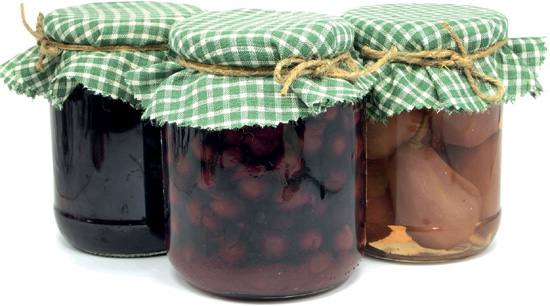People who are sensitive to acids tolerate canned fruit better than fresh fruit.
Canning is a relatively simple—and traditional—method of preserving fruit and vegetables that gives you a handy supply of tasty produce throughout the year.
In addition to metal clip-top or screw-top jars, you will need the following tools for preserving fruits and vegetables: kitchen scales, measuring cup, skimmer and funnel. A jar lifter (available online) makes it easier to remove jars from the hot water, and don’t forget labels for the filled jars.
• Choose canning jars (also called mason jars) with rubber seals, glass lids and spring closures.
• Check all canning jars for scratches and chips.
• Check the rubber seals used to keep the jars airtight for brittle spots.
• Before adding preserves, boil the jars and seals in vinegar and water and drip dry, upside down.
• You can also sterilize jars in the oven: Place them on a cookie sheet lined with a paper towel for 10 minutes in an oven preheated to 325°F (160°C).
• If you choose to boil them in a saucepan, make sure the jars are all the same height and they don’t touch the top edge of the pan.
• Place jars in warm water, then increase the heat; they can crack if placed directly into boiling water.
• When preserving in the oven, place the jars on a shelf or cookie sheet. Don’t preheat.
In theory, all types of fruit can be preserved safely because they are naturally acidic and the added sugar will help to preserve them. Fruit compotes with ice cream or pancakes make a delicious winter treat.
1 Boil down about 4 pounds (2 kg) fruit with 1 quart (1 L) water and 11/4 cups (300 g) sugar into a syrup.
2 Adjust the amount of sugar to the natural sugar content of the fruit to achieve a balanced taste.
3 Place your washed and chopped fruits in lemon water to keep them from oxidizing and turning brown.
4 Layer the fruit in the jar no higher than 1 inch (2.5 cm) below the rim.
5 Pour the boiling sugar syrup over the fruit, seal the jars and lower them into a saucepan of boiling water to cover by a least 2 inches (5 cm), or place in the oven at 195°F (90°C). Boil or heat for 30 minutes or use a pressure cooker to manufacturer’s instructions.
You can get good results preserving cucumbers, carrots, peppers and tomatoes. Beans, peas, red cabbage and celery are also good choices. However, because they need to be heated to high temperatures, you must cook nonacidic vegetables in a pressure cooker before canning or you may end up with food poisoning. Follow the manufacturer’s instructions.
• Layer the vegetables tightly in the jars and cover with a boiling salt solution consisting of 1 tablespoon (15 ml) salt and 1 quart (1 L) water.
• Leave a top space of about 3–4 inch (1.5 cm) when filling. Too much space may result in discoloration of the top layer; too little headspace may cause the vegetables to swell and break the seal.
• Acidic vegetable mixtures containing tomatoes can be preserved at a temperature of 195°F (90°C) for 90 minutes. A mixture containing beans needs 2 hours, but tomatoes with eggplant need only 30 minutes at 185°F (85°C) or they become too soft.
• Shorten preserving time by blanching or half-cooking firm vegetables such as carrots in advance.
• If the bottled vegetables aren’t crisp, the salt solution isn’t strong enough.
• If they turn dark, use distilled water next time. Chemicals in tap water can produce a dark coloring.
• Remove the rings on canning jars only after they have cooled completely (usually overnight).
• Check to be sure the jars are sealed by pressing down gently on the top with your finger. If it pops up and down (it may even make a popping sound), it isn’t sealed. If the lid has been sucked down, it has worked correctly.
• If there is no vacuum, put the jar in the fridge and be sure to eat the contents promptly.
• You can keep preserved fruit or vegetables in a dark, cool location for up to a year.
• If the canning jar resists opening, place it right side up in a pot of hot water to reduce the inner pressure. The jar will open more easily.
GOOD TO KNOW 
Jam jars work just as well
Instead of canning jars, you can use jam jars or vegetable jars with screw tops. The important thing is that they form an airtight seal and are free from damage. Just be aware that acids can attack uncoated metal and release substances that leach into the preserves. Clean and boil the jars and lids thoroughly before use.
IN THEORY, ALL FRUIT CAN be preserved SAFELY.
